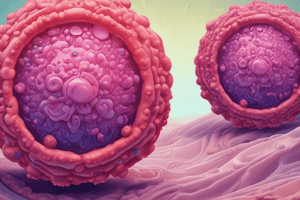Podcast
Questions and Answers
What type of organism is Neisseria gonorrhoeae?
What type of organism is Neisseria gonorrhoeae?
- Gram positive coccus
- Gram positive bacillus
- Gram negative diplococcus (correct)
- Gram negative rod
Which biochemical test is positive for Neisseria gonorrhoeae?
Which biochemical test is positive for Neisseria gonorrhoeae?
- Urease
- Oxidase (correct)
- Indole
- H2S production
Which growth condition is required for Neisseria gonorrhoeae?
Which growth condition is required for Neisseria gonorrhoeae?
- Blood agar with 5-10% CO2 at 35-36°C (correct)
- Ordinary nutrient agar at 25°C
- Eosin methylene blue agar at 30°C
- MacConkey agar at 37°C
What complication can occur if Neisseria gonorrhoeae invades the bloodstream?
What complication can occur if Neisseria gonorrhoeae invades the bloodstream?
Which population is commonly affected by gonococcal valvo-vaginitis?
Which population is commonly affected by gonococcal valvo-vaginitis?
What type of colonies does Neisseria gonorrhoeae form on enriched media?
What type of colonies does Neisseria gonorrhoeae form on enriched media?
Study Notes
Aetiology
- Neisseria gonorrhoeae is the causal organism of gonorrhea.
Morphology and Growth
- Gram negative, kidney-shaped diplococci with opposed surface concave, and the long axis of the pair parallel to each other.
- Found extracellularly and intracellularly in pus cells in smears of exudates.
- Loeffler's methylene blue stain defines morphology more clearly.
- Aerobes and facultative anaerobes requiring 5-10% CO2 for isolation.
- Do not grow on ordinary culture media (nutrient agar).
- Grow on enriched media, such as blood agar and Chocolate agar.
- Optimal growth temperature is 35-36°C.
- Colonies are small, glistening, gray, and slightly convex.
Biochemical Tests
- Oxidase test: positive
- Catalase test: positive
- Fermentation tests:
- Glucose: ?
- Maltose: ?
- Sucrose: ?
- Lactose: ?
Complications
- Blood invasion leading to bacteremia
- Arthritis and tenosynovitis
- Secondary gonococcal conjunctivitis
- Septic gonococcal dermatitis, arthralgia, and fever
Gonococcal Vulvovaginitis
- Affects females, especially children, and newborns
Plate Method
- Culture is made on oxidase reagent, which is then decanted
- Wet filter paper method
- Dry filter paper method
- Strips of Whatman paper are used, which retain a purple tint and remain moistened after draining.
Studying That Suits You
Use AI to generate personalized quizzes and flashcards to suit your learning preferences.
Description
This quiz covers the morphology and growth characteristics of Neisseria gonorrhoeae, the causal organism of gonorrhea. Learn about its gram staining, shape, and growth requirements.



